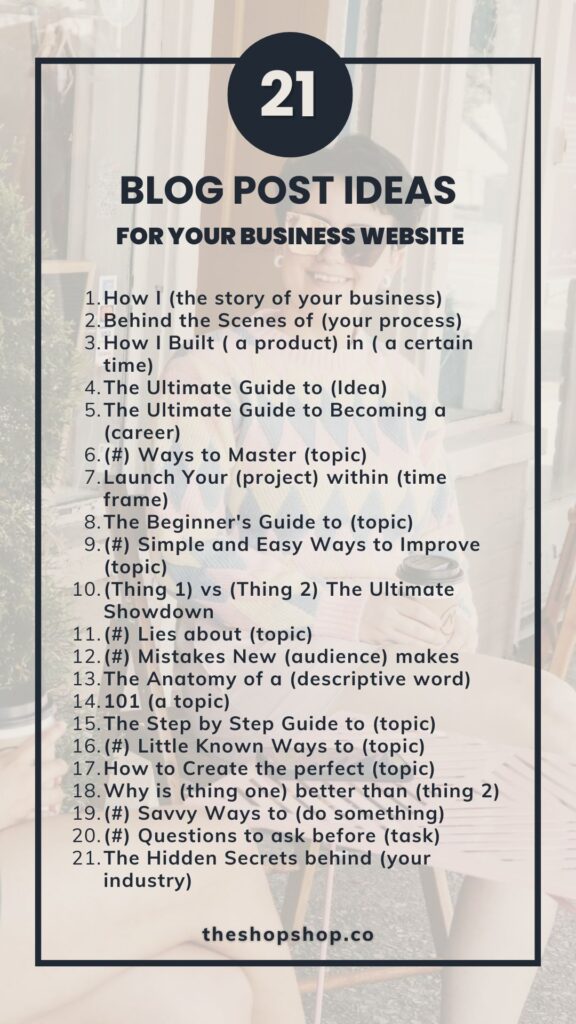Every time I build a business website, we have the same conversation about blogging. Most people think of lifestyle blogging (or even social media posts) when we talk about adding a blog to their website. However, from a development standpoint, it means your website will be able to hold posts in addition to pages. Posts can be organized by category and tag. They can also be pulled into archive pages. (By contrast, pages have a parent/child relationship). The blogging system creates a wealth of content opportunities. It’s a key part of my SEO services at my Lynchburg, Virginia agency. However, business owners assume I want them to write posts about what they had for dinner or their random thoughts on current events.
Common Misconceptions about Business Blogging
Business blogs should focus on producing valuable content for prospective and current customers. It’s a way for them to find and engage with your business. These posts take the form of articles, lists, and long-form content (1,500 – 3,000 words) that educates or entertains your customer.
Blog Post Ideas for your Business Website
Based on this, I suggest several formats for business blog posts. Some of them include:
- How I (the story of your business)
- Behind the Scenes of (your process)
- How I Built ( a product) in ( a certain time)
- The Ultimate Guide to (Idea)
- The Ultimate Guide to Becoming a (career)
- (#) Ways to Master (topic)
- Launch Your (project) within (time frame)
- The Beginner’s Guide to (topic)
- (#) Simple and Easy Ways to Improve (topic)
- (Thing 1) vs (Thing 2) The Ultimate Showdown
- (#) Lies about (topic)
- (#) Mistakes New (audience) makes
- The Anatomy of a (descriptive word)
- 101 (a topic)
- The Step by Step Guide to (topic)
- (#) Little Known Ways to (topic)
- How to Create the perfect (topic)
- Why is (thing one) better than (thing 2)
- (#) Savvy Ways to (do something)
- (#) Questions to ask before (task)
- The Hidden Secrets behind (your industry)
Each of these formats creates a solid starting point for meaningful content related to your specific industry.

SEO Tips for Writing Blog Posts on a Business Website
One of the most effective ways to enhance your visibility is by maintaining a blog on your business website. However, simply writing content isn’t enough; you need to ensure your blog posts are optimized for search engines. Here are some essential SEO tips to help your blog posts rank higher and attract more visitors.
1. Conduct Thorough Keyword Research
Keywords are the foundation of SEO. They help search engines understand the content of your blog post and connect it with users’ search queries. To find the right keywords:
- Use tools like Google Keyword Planner, SEMrush, or Ahrefs to identify relevant keywords with high search volume and low competition.
- Focus on long-tail keywords, which are more specific and often less competitive.
- Integrate primary and secondary keywords naturally throughout your content, including in your titles, headings, and meta descriptions.
2. Craft Compelling, SEO-Friendly Titles
Your blog post title is the first thing potential readers see. A well-crafted title can improve both click-through rates and SEO. To optimize your titles:
- Include your primary keyword near the beginning.
- Keep it under 60 characters to ensure it displays fully in search results.
- Make it engaging and informative, giving readers a reason to click.
3. Optimize Your Meta Descriptions
Meta descriptions are short summaries that appear under your page title in search engine results. Although they don’t directly affect rankings, they can influence click-through rates. To create effective meta descriptions:
- Keep them under 160 characters.
- Include your primary keyword.
- Provide a clear and enticing summary of your content that encourages users to read more.
4. Use Header Tags Strategically
Header tags (H1, H2, etc.) help organize your content and make it easier for readers and search engines to understand. Here’s how to use them effectively:
- Use one H1 tag for the main title of your blog post.
- Utilize H2 tags for subheadings to break up your content into sections.
- Incorporate keywords naturally within your header tags to improve relevance and SEO.
5. Incorporate Internal and External Links
Linking is beneficial for SEO as it helps search engines understand the context of your content and boosts credibility. Consider the following:
- Use internal links to connect related blog posts and pages on your website. This keeps readers engaged and enhances site navigation.
- Include external links to authoritative sources, which can add value to your content and improve your site’s trustworthiness.
6. Optimize Images and Alt Text
Images make your blog posts more engaging, but they also need to be optimized for SEO. Follow these tips:
- Use descriptive filenames for your images, with hyphens between words (e.g., seo-tips-business.jpg).
- Compress images to improve page loading speed.
- Include relevant keywords in your alt text to help search engines understand the image content.
7. Ensure Mobile-Friendliness and Fast Loading Speeds
With the majority of users accessing content on mobile devices, having a mobile-friendly website is crucial. Additionally, fast loading speeds improve user experience and are a ranking factor. To optimize for both:
- Use responsive design to ensure your blog is accessible on all devices.
- Minimize the use of large files and plugins that can slow down your site.
- Consider tools like Google PageSpeed Insights to assess and improve your site’s loading speed.
8. Monitor and Analyze Performance
Finally, regularly monitor the performance of your blog posts to identify areas for improvement. Use tools like Google Analytics and Google Search Console to:
- Track traffic, engagement, and conversion metrics.
- Identify which keywords and topics are performing well.
- Adjust your strategy based on data to continually enhance your blog’s SEO performance.
By implementing these SEO tips, you can create blog posts that not only engage your audience but also boost your visibility and ranking on search engines.
Writing for Your Business Website
As you work through posting for your business, you’ll find it’s easy to create content with this mindset. Instead of rambling about your personal life or pontificating about your industry, find ways to help your customers. Those topics should come easily for any business owner. If you focus on these, your content plans follows naturally.
About The Shop Shop
Working with us is simple. We’ll make sure your products are online and ready to sell. And you can get back to the parts of your business that you love. Learn more about working with us!

Understand Shopping Trends
We’re dropping our next newsletter in July 2025. Sign up for exclusive freebies, giveaways, and industry insights.


